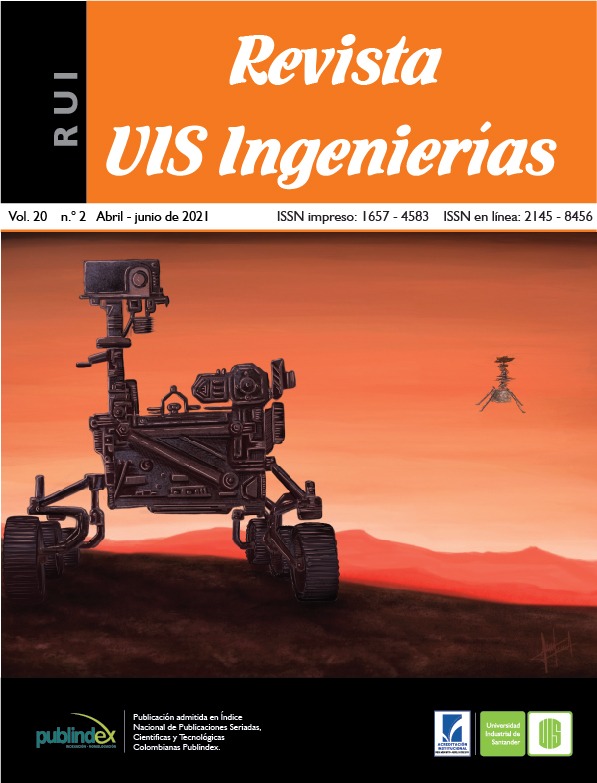Comparative between the binary thresholding technique and the Otsu method for the people detection
Published 2021-01-02
Keywords
- people detection,
- comparative,
- binary thresholding,
- Otsu method,
- Python
- Matlab,
- time,
- memory,
- machine requirement,
- hits ...More
How to Cite
Abstract
In image detection processes where there is a variation in brightness between pixels, techniques are required to obtain optimal and adaptable threshold values for these variations. Therefore, a comparison between the binary thresholding technique and the adaptive method of Otsu is made, in videos with dynamic and static background, weighing the response time of the algorithm, memory used, requirement of the central processing unit and hits in the detections, in the languages of Python and M (Matlab). The techniques in Python present better results in terms of response time and memory space; while, when using Matlab, the lowest percentage of machine requirement is presented. Also, the Otsu method improves the percentage of hits in 12.89 % and 11.3 % for videos with dynamic and static background, with respect to the binary thresholding technique.
Downloads
References
[2] D. L. Siqueira, A. Manso Correa MacHado, “People Detection and Tracking in Low Frame-rate Dynamic Scenes”, IEEE Lat. Am. Trans., vol. 14, no. 4, pp. 1966-1971, 2016, doi: 10.1109/TLA.2016.7483541
[3] C. V. Niño Rondón, S. A. Castro Casadiego, B. Medina Delgado, D. Guevara Ibarra, “Análisis de viabilidad y diseño de un sistema electrónico para el seguimiento de la dinámica poblacional en la ciudad de Cúcuta”, Ing. USBMed, vol. 11, no. 1, pp. 56-64, 2020, doi: 10.21500/20275846.4489
[4] C. Raghavachari, V. Aparna, S. Chithira, V. Balasubramanian, “A Comparative Study of Vision Based Human Detection Techniques in People Counting Applications”, Procedia Comput. Sci., vol. 58, pp. 461-469, 2015, doi: 10.1016/j.procs.2015.08.064
[5] J. Maldonado Beltrán, C. Peña Cortés, O. Gualdrón González, “Identificación automática de cilindros de almacenamiento de gas utilizando redes neuronales tipo hopfield”, Rev. UIS Ing., vol. 11, no. 1, pp. 103-111, 2012.
[6] S. Shoba, R. Rajavel, “Image Processing Techniques for Segments Grouping in Monaural Speech Separation”, Circuits, Syst. Signal Process., vol. 37, no. 8, pp. 3651-3670, 2018, doi: 10.1007/s00034-017-0728-x
[7] M. Paul, S. M. E. Haque, S. Chakraborty, “Human detection in surveillance videos and its applications - a review”, EURASIP J. Adv. Signal Process., vol. 2013, no. 1, pp. 1-16, 2013, doi: 10.1186/1687-6180-2013-176
[8] E. N. Kajabad, S. V. Ivanov, “People Detection and Finding Attractive Areas by the use of Movement Detection Analysis and Deep Learning Approach”, Procedia Comput. Sci., vol. 156, pp. 327-337, 2019, doi: 10.1016/j.procs.2019.08.209
[9] F. T. Aleskerov, V. V. Chistyakov, “The threshold decision making”, Procedia Comput. Sci., vol. 17, pp. 1103-1106, 2013, doi: 10.1016/j.procs.2013.05.140
[10] C. V. Niño Rondón, S. A. Castro Casadiego, B. Medina Delgado, “Caracterización para la ubicación en la captura de video aplicado a técnicas de visión artificial en la detección de personas”, Rev. Colomb. Tecnol. Av. RCTA, vol. 2, no. 36, pp. 83-88, 2020, doi: 10.24054/16927257.v36.n36.2020.3720
[11] B. López-Portilla Vigil, R. Menéndez Alonso, M. Iglesias Martínez, “Implementación del Algoritmo de Otsu sobre FPGA”, Rev. Cuba. Ciencias Informáticas, vol. 10, no. 3, pp. 16-26, 2016.
[12] P. Huamaní Navarrete, “Umbralización múltiple utilizando el método de Otsu para reconocer la luz roja en semáforos”, Scientia, vol. 17, no. 17, pp. 247-262, 2016, doi: 10.31381/scientia.v17i17.393
[13] E. Ieno, L. M. Garcés, A. J. Cabrera, T. C. Pimenta, “Simple generation of threshold for images binarization on FPGA”, Ing. e Investig., vol. 35, no. 3, pp. 69-75, 2015, doi: 10.15446/ing.investig.v35n3.51750
[14] J. F. Ramos, D. Renza, D. M. Ballesteros L., “Evaluation of spectral similarity indices in unsupervised change detection approaches”, DYNA, vol. 85, no. 204, pp. 117-126, 2018, doi: 10.15446/dyna.v85n204.68355
[15] N. Triana, A. E. Jaramillo, R. M. Gutiérrez, C. A. Rodríguez, “Técnicas de umbralización para el procesamiento digital de imágenes de GEM-Foils”, Sci. Tech., vol. 21, no. 4, pp. 352-261, 2016.
[16] A. Gómez-Villa, G. Díez-Valencia, A. E. Salazar-Jimenez, “A Markov random field image segmentation model for lizard spots”, Rev. Fac. Ing., vol. 2016, no. 79, pp. 41-49, 2016, doi: 10.17533/udea.redin.n79a05
[17] M. Huang, W. Yu, D. Zhu, “An improved image segmentation algorithm based on the Otsu method”, en Proc. - 13th ACIS Int. Conf. Softw. Eng. Artif. Intell. Networking, Parallel/Distributed Comput. SNPD 2012, pp. 135-139, doi: 10.1109/SNPD.2012.26
[18] J. Cortes Osorio, J. Chaves Osorio, J. Mendoza Vargas, “Comparación cualitativa y cuantitativa de las técnicas básicas de umbralización local para el procesamiento digital de imágenes”, Sci. Tech., vol. 2, no. 51, pp. 236-241, 2012, doi: 10.22517/23447214.1539
[19] G. Cavanzo, M. Pérez, F. Villavisan, “Medición de eficiencia de algoritmos de visión artificial implementados en raspberry pi y ordenador personal mediante Python”, Ingenium, vol. 18, no. 35, pp. 105-119, 2017, doi: 10.21500/01247492.3218
[20] N. I. Maya Perfetti, A. M. Nuñez Bedoya, H. A. Romo Romero, “Análisis de rendimiento de algoritmos de reconocimiento de placas de números de vehículos desarrollado mediante la transformación de ondas discretas y la correlación de imagen digital”, Investig. e Innovación en Ing., vol. 7, pp. 133-141, 2019, doi: 10.17081/invinno.7.1.2990
[21] G. Sánchez-Torres, J. A. Taborda-Giraldo, “Estimación automática de la medida de ocupación de playas mediante procesamiento de imágenes digitales”, TecnoLógicas, vol. 17, no. 33, pp. 21-30, 2014.
[22] G. Vargas, O. Neira, R. Arango, D. Fernando, “Métodos de segmentación de nubes en imágenes satelitales Cloud segmentation methods applied to satellite images”, Tecnura, vol. 17, no. 36, pp. 96-110, 2013, doi: 10.14483/udistrital.jour.tecnura.2013.2.a08
[23] E. S. Gedraite, M. Hadad, “Investigation on the effect of a Gaussian Blur in image filtering and segmentation”, en Proc. Elmar - Int. Symp. Electron. Mar., 2011, pp. 393-396.
[24] L. Neumann, A. Vedaldi, “Tiny People Pose”, Lect. Notes Comput. Sci. (including Subser. Lect. Notes Artif. Intell. Lect. Notes Bioinformatics), vol. 11363 LNCS, pp. 558-574, 2019, doi: 10.1007/978-3-030-20893-6_35
[25] J. D. Guerrero Balaguera, “Algoritmos De Procesamiento De Imágenes Y Redes Neuronales Artificiales Para El Reconocimiento De La Lengua De Señas Colombiana (Lsc) Image Processing Algorithms and Artificial Neural Networks To Recognition of Colombian Sign Language (Lsc)”, Rev. Colomb. Tecnol. Av. RCTA, vol. 2, no. 28, pp. 1-8, 2016.


